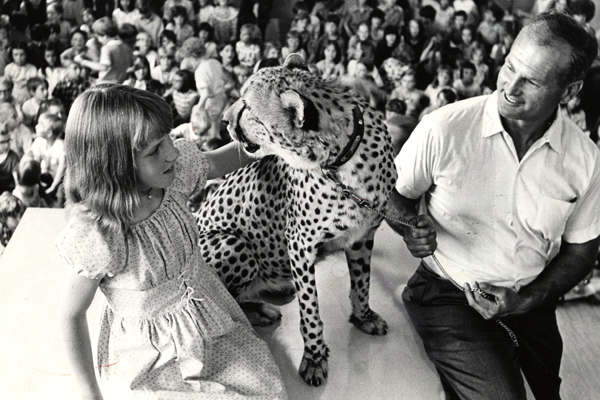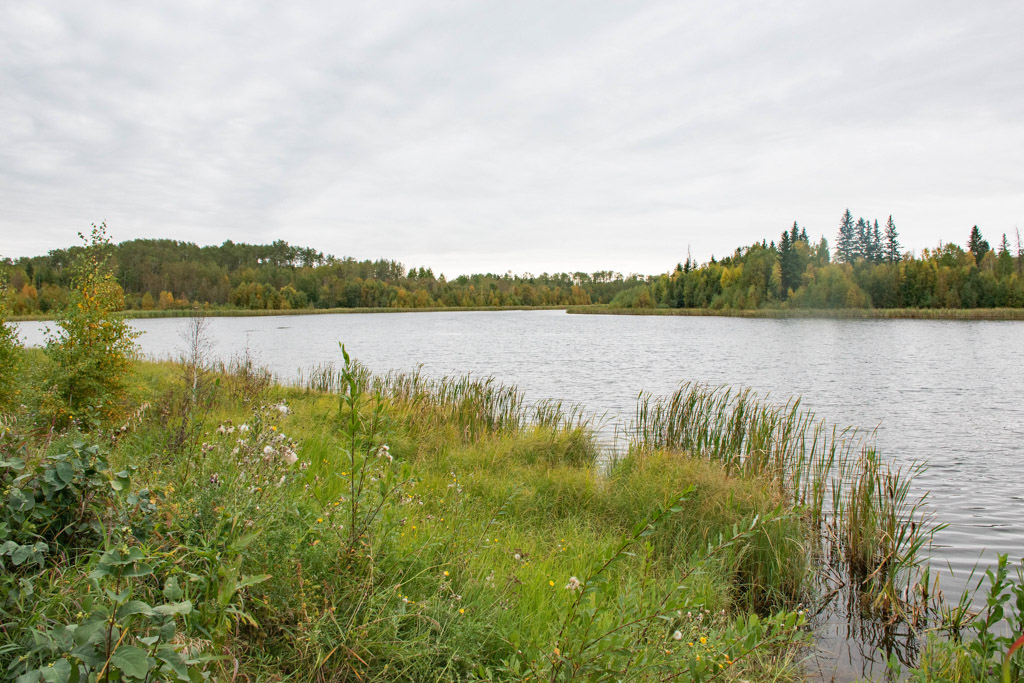One of the legendary places in the Ministik area was Al Oeming’s Alberta Game Farm. It operated from 1959 to 1980 (when it was rebranded “Polar Park”). The 1,400-acre facility started at Highway 14 and Range Road 223 and grew to house hundreds of exotic species. The most famous of his animals were the cheetahs.

Fun with the Cheetahs
When Al Oeming first brought cheetahs to his Game Farm, he had them in a large enclosure and wanted to give them some stimulation and exercise. So, he rigged up a long clothesline arrangement on two bicycle wheels across the enclosure and suspended a broom from it at one point. The setup was powered by an electric motor with stops at each end to make the broom go back and forth.
The cats enjoyed chasing the broom and swatting at it much like tetherball. They were thus conditioned to play with brooms and he had that arrangement in their enclosure for as long as he had the Game Farm.
Al had one older, well trained, cheetah that he used to take out in public for demonstration and public relations purposes. He used to take her to schools. When I was teaching, he brought her into my classroom to show the class and tell them about cheetahs. At one point he had me get down on all fours beside my desk to allow the cheetah to step on my back to get on top of my desk. It was a delightful stunt and the children loved it but the cheetah certainly did not require me as a stepping stone as they can jump many times higher than my desk.
Al would typically show his cheetah in schools during the last period of the day, then take it to the staff room to show the teachers and have a visit while the children left for home. Then, when everyone was gone, he would take the animal to his car and go home.
One time, a few years later, he took his cheetah to Ministik School and showed it there. After the showing, he took the cheetah to the staff room as was his routine, while all the children boarded their buses and left the school yard.
As Al was walking his cheetah off leash and at heel to his station wagon, the school caretaker, unaware of the presence of the cat on the premises, opened the back door of the gym and proceeded to shake out his dust mop. Upon seeing this, the cheetah, thinking it was play time, broke heel and headed for the attractive dust mop at high speed. The caretaker spotted the cheetah at the last minute, dropped the mop and slammed the door to save himself, getting the fright of his life.
The Cougars
The Game Farm had a large enclosure of cougars with many vertical trees and numerous horizontal ones secured among them at about ten or twelve feet in the air for the cougars to lounge on. On one visit, there was a family group with an infant in a stroller viewing the cougars through the double fence and from behind a low rail barrier outside that. Because it was such a large enclosure and there were many cougars there lounging in various poses, it was very interesting and it took some time for people to pass this area.
At one point, a young cougar left his lounging spot and was soon stalking the family group, with his tail twitching. When the family group moved over, he also changed his course. Soon, an older cougar slipped down from her perch in a horizontal tree and positioned herself, nonchalantly, between Junior and the family. As Junior crept by she gave him a stiff cuff sending him rolling and looking very indignant and self-righteous.
Once again the family moved over and soon Junior was again stalking, but with one eye cautiously on Mama and one eye on the intended prey, trying to appear innocent. Someone suspected that the cougar was eyeing the tender infant in the stroller and when they moved over about eight feet more, they left the stroller where it was and, sure enough, the cougar was focused directly on the tender morsel behind the fences and did not even miss the presence of the rest of the family.
This family shall remain nameless to protect the innocent and the reputation of the father for using his child as “cougar bait” in the name of research.
Visit the Edmonton Journal’s photo gallery for more photos from the Game Farm
The One about the Compass
There was a story about a man, nearing retirement, who was casting about for ideas regarding what he might do after his retirement. He read about a man named Tates who had developed a new compass and was wanting to sell the rights to it to someone who was interested in marketing it.
He managed to get the rights to it and was marketing it when he went out on a hike one day and failed to return. His wife reported him missing and lost, so Search and Rescue went out in search of him.
They were soon able to find him and the ranger told the wife that he had been found in good health and that they were bringing him out.
His wife said that she couldn’t understand how he could get lost as she knew that he always had a compass with him. The ranger said that the husband should get rid of that Tates compass.
So the wife asked how he knew that her husband had a Tates. The ranger told her that it was common knowledge among the rangers and Search and Rescue people that “He who has a Tates is lost.”
